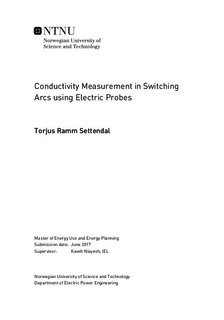Conductivity Measurement in Switching Arcs using Electric Probes
Master thesis
Permanent lenke
http://hdl.handle.net/11250/2451781Utgivelsesdato
2017Metadata
Vis full innførselSamlinger
- Institutt for elkraftteknikk [2503]
Sammendrag
Due to its excellent arc quenching capability, SF6-gas is widely used for medium voltage switchgear. Because it is a highly potent greenhouse gas, it is expected to be many restrictions for the allowed use of this gas in near future. It is therefore important to conduct research on development of more environmental friendly switchgear. The challenge is to keep both the interruption capability and volume, of todays SF6 insulated switchgear. One of the most promising solution to this challenge, is to use ablation material to improve the current interruption capability. Experimental work with an ablation-assisted circuit breaker, is the foundation for the work in this thesis.
The primary aim of this thesis is to evaluate the arc voltage distribution inside an ablation tube during ablation-assisted current interruption, using air as the insulation medium. This is performed by gathering the readouts from three high voltage resistive probes placed at different key locations in the plasma arc.
The first part of the thesis contains work performed to weed out any large sources of measurement error. From previous work, it was found that the experimental setup used in this work contained one or more of these sources. The second part of this work contains the experimental portion of this work. This part explains how the tests were conducted, and lists the results together with a discussion around their significance and wider implications.
By applying the corrections suggested in this work, the probes gave valuable results for conductivity measurements in switching arcs. The results are considered valid for measurements from contact separation and until 100 $\mu$s after current interruption.
The results show clearly that the field strength was significantly higher where the gas outlet was located, when the pressure inside the ablation tube was low.When acting as a "self-blast" switch, which increased the pressure, gave the system an increase in field strength. Additionally, there was also a change in the position of the field strength peaks. With an increase in pressure, the field strength changed from being largest over the gas outlet to being largest over the first few millimeters of the arc.
